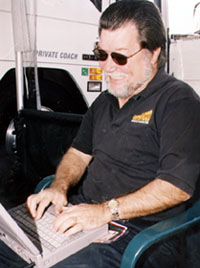| | | |||
 | ||||
|
A case in point was Dallas International Motor Speedway, a multi-use Texas racing facility built in 1968 and featuring, among other things, a four-level VIP tower with a top floor lounge accessed by elevator and paved pits. So spectacular was DIMS that it was the first track ever awarded rights to two different NHRA national events (the 1969 and 1970 Spring nationals and World Finals). It was a showcase stadium in an era in which amenities like permanent restrooms, paved parking and freeway access (via two separate ramps to I-35E) were about as common as corporate sponsorship, which is to say, not common at all. Unfortunately, it proved to be an era in which the sport could not financially support all those “extras.” Facing foreclosure, DIMS president Ben Parks (no relation to NHRA founder Wally Parks), offered the facility to the NHRA for a price that today would make grown men cry like little newborns. Unfortunately for us all, the offer was presented at a time when the NHRA was “not in the racetrack ownership business.” As a result, after a couple of seasons under NHRA sanction and with creditors gnawing at the asphalt, the track was shut down in 1973 and sold to developers. Today, DIMS, a track 25 years ahead of its time, lies beneath a strip shopping center in Lewisville, Texas. There’s no headstone identifying its last resting place; no plaque designating its one-time location; no tree planted in honor of Ben Parks, Vance Jobs or the other enthusiast / investors whose vision went unrewarded. Jump ahead 20 years, to the 1990’s. The NHRA, perhaps acknowledging the mistake it made at DIMS, is very much in the racetrack ownership business. Unfortunately, among its purchases are National Trail Raceway outside Columbus, Ohio, and Atlanta Dragway, two properties which today hang like albatri (what is the plural of albatross?) around the company’s corporate neck. But, never fear, good citizens, the pendulum appears again to be swinging in the other direction and this time, NHRA might just get it right. In an arrangement reportedly being bartered between the sanctioning body and an investor group fronted by K.C. Spurlock, Columbus and Atlanta would become part of a power bloc that also would include Seattle International Raceway, proposed tracks in Detroit and in New England (two locations where the sport long has coveted a presence) and Houston Raceway Park. Although two years remain on its existing contract, Seattle supposedly is a done deal. Atlanta and Columbus are there for the taking. Houston might be the sticking point although the track has been the subject of sale rumors for years. Should the parties cross all the T’s and dot all the I’s, what does NHRA derive from the deal? Quite a bit, really. For one thing, it unloads a couple of tracks that have been a constant drain on its resources. Since NHRA forced Ben Rader to sell National Trail Raceway, the track has become nothing more than a money pit with little visible resolution to problems that have plagued it for years. The money spent there and at Atlanta would have been better used at Indianapolis Raceway Park which, as the self-proclaimed showcase for NHRA drag racing, has become an embarrassment when compared to tracks like The Strip at Las Vegas Motor Speedway, Route 66 and Bristol Dragway. So, NHRA sheds itself of some of its debt load. More important, the High Sheriffs get a second 600-pound gorilla to offset the growing influence of the one already loose in the zoo. The proposed six-track union presumably would control six NHRA national events. That would be at least two more than tracks presently operated by Bruton Smith's organization, he being the original 600-pound gorilla. The strategy here is a dangerous one, but one that could benefit the sport immensely in the long run: one gorilla can apply a strong arm to address its own agenda. On the other hand, with two gorillas in the same cage, NHRA can play one off the other to maintain a certain degree of balance. Of course, all that depends upon consummation of a very complicated deal. It’s kind of like signing a race car sponsor. An agreement that’s 99.9 % done is just like one that’s 10 % done. Easily undone.
Dave Densmore, a paid columnist for DRO, also works for John Force. Photo by Jeff Burk
| ||||
|
Copyright 1999-2001, Drag Racing Online and Racing Net Source | ||||

